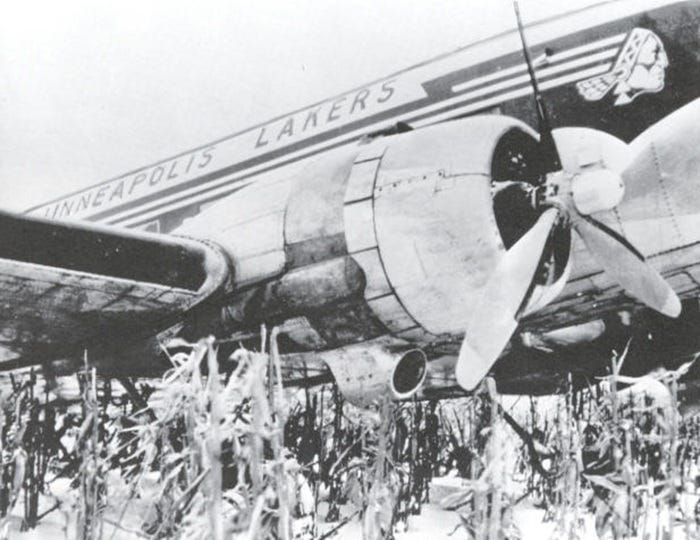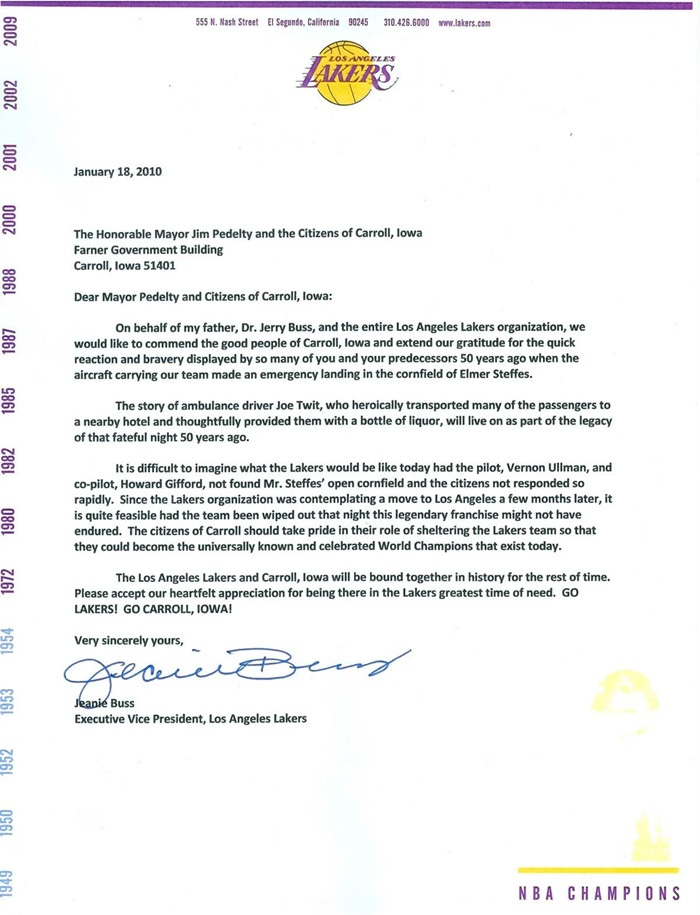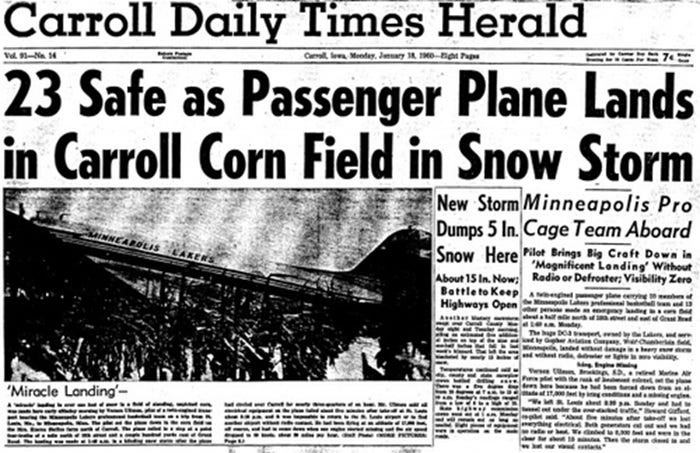
It was a cold day in Carroll, Iowa a week ago Saturday when Maren and I veered a little off course on our way back to Jackson after a quick one-day trip to Omaha.
For the record, we’d seen Jerry Seinfeld and Jim Gaffigan perform the night before. Great show. But I digress.
Since buying the tickets we’d been trying to decide what to do the day after the show, either in Omaha or along the way.
Only a couple days before the trip I remembered regretting not going to this site in Carroll in August 2019 when we’d taken a trip to Kansas City to see Billy Joel and Stevie Nicks. And we stopped in Carroll twice on that trip, going down and coming back.
Honestly, I’m not trying to impress anyone that we attend a lot of shows.
That said, we’re going to see Nate Bargatze in St. Paul in July and I continue to lobby to attend another show in between in April.
Again, I digress.
Growing up I’d heard a story that a plane carrying the Minneapolis Lakers making an emergency landing in an Iowa cornfield. I’d honestly never thought about it much until a few years ago when coming across a story that the now Los Angeles Lakers had donated an outdoor basketball court in Carroll in 2010 in recognition of the 50th anniversary of the landing.
Once I started checking into visiting Laker Court in Carroll, I discovered that we would be there on the 65th anniversary of what signage in what is now Veterans Memorial Park calls “The Miracle Cornfield Landing of 1960.”
It doesn’t appear that there was any observance of the anniversary.
In the fewer than 30 minutes we were there we didn’t see another person. It wouldn’t be surprising though if there were people looking out from the town houses that lined the property wondering why some guy was wandering around in the cold looking at an empty basketball court on a Saturday morning in January.
Late in the afternoon of Sunday, Jan. 17, 1960, a tired Lakers team was ready to return home after playing three games in as many days. Each game was a loss, dropping their record to 13-30.
The previous Friday the Lakers lost 122-118 at Cincinnati to the Royals. They played a home game at St. Paul Auditorium, 105-98 to the Detroit Pistons on Saturday night. Following that was a Sunday matinee at St. Louis, where Minneapolis lost 135-119 to the Hawks.
The Lakers were the NBA’s first dynasty, winning the title three straight years and five times in six years.
Their owner, Bob Short, was well known for his, well, thriftiness. The team traveled on a DC-3, a converted World War II cargo plane that Short had purchased.
The Lakers had arrived at the airport around 5:30 following the loss to the Hawks to learn that an ice storm had grounded all flights.
The severe weather subsided somewhat over the next few hours, the players boarded the plane, and finally the decision was made to go. The plane lifted off at 8:30.
After the plane was airborne, players brought out their makeshift card table and placed it in the aisle. That’s when the lights went out. Coach Jim Pollard went to the front of the plane to find out what was going on and saw the co-pilot shining a flashlight on the instrument panel.”
The plane’s two generators had failed, and the battery was drained of its remaining power immediately. All the time spent on the ground deciding whether or not to take off had run the battery down. As soon as the generators were lost, there was no electrical power.
Returning to St. Louis was not an option, because the plane's radio, like everything else, wasn't working. The pilots tried to fly above the storm but couldn't get out of the snow.
"We headed for Minneapolis, and lo and behold, we run into a snowstorm," player Bob "Slick" Leonard said years later. "And old Tommy Hawkins, from Notre Dame, we were sitting there together, and we had a blanket over our heads. He said 'Slick, do you think we're gonna die?' I said 'naw, we're not gonna die.' And he said 'the hair is standing straight up on the back of my neck.'"
The pilots had to open the windows of the cockpit to brush off the snow, because the windshield wipers were inoperative. One of the pilots was frostbitten across half of his face. No one knew where they were, but everybody knew the plane was running out of fuel and had to land soon.
"The moon was out, and we were lost, so we started following this car," Leonard said. "They weren't flying that high. They thought the headlights would lead them into a town. And that damn thing was heading up a hill. And all of a sudden (the pilot) yanks up on that thing and we go back up."
"Finally, the pilot said 'listen, I'm going to go down; I think I see a field that we might can land (in),' and he told everybody to get ready," said Elgin Baylor, who was in his second season in the NBA at the time.
First, though, the pilots had to make several passes over the land to try and figure out the terrain of the countryside. Also, they had to fly around and over power lines, as well as a water tower.
“One guy who lived by the water tower, he took his kids to the basement,” Carroll resident John Steffes told agweb.com. “It just shook the house. It’s a loud plane. So, when you buzz the town at least nine times, you’re waking people up.”
A wet fall had prevented the area from being harvested, and the pilots decided it would become their runway.
Reportedly Baylor (who was not fond of flying to being with), was lying down on the floor in back. He said “’If we’re going to crash, I might as well go comfortably.’”
At last, the pilots dropped the plane down into the field. While Baylor says it was "the smoothest landing I ever had," Leonard recalled it a little differently.
"The story is that, and I didn't turn around to see it, so I don't know if Elgin was lying in the aisle or not," he said. "The (corn) shucks were still up and it was just ripping through there. We were in that crash position. And then we stopped, and one pilot had that backdoor open really quick, and now, here we are in a cornfield, and we're so happy. The snow was clear up to your chest ... we started throwing snowballs at each other and everything."
They were in Carroll, and they were lucky. About 75 yards or so ahead, Leonard said, was "a drop-off like you wouldn't believe. That plane would've gone down that gorge and probably exploded."
The first civilian to greet them, imponderably, was the town mortician, whose house the plane had buzzed.
"We told him, ‘No business for you today,'" Baylor said.
The players rode hearses into town and stayed the night at a local senior retirement hotel.
"There was a small bar there, that sat maybe five or six people," Leonard said. "And some of these old retirees, they came out, the ladies had their nightgowns on, and they wanted to know what was going on. And old Larry Faust, he's dead now, saw that the liquor cabinet had a lock on it. He took a hold of that lock and just twisted that thing off and got himself a big glass and poured himself some VO and sat down."
The Lakers took buses back to Minneapolis. The next trip out was a few days later, to Detroit to play Cincinnati. On the same plane.
"We told Short, 'we're not getting on that baby,'" Leonard said. "He said 'you either get on, or you're out of a job.' We got on that baby and flew again."
"They assured us everything was fine," Baylor said. "So, we fly to Detroit and we play (and win 116-112), and get back on the plane and we're flying back. And the late Jim Krebs, he was on one side of the plane, and he was looking out, and he said 'hey, look, the airport.' We were only like 400 or 500 feet up. We thought it was an emergency for a plane that was coming in, or something like that. Fire trucks, you see the lights. It was for us. What had happened was, we had an oil leak, and the engine caught fire."
After that, the Lakers moved to Los Angeles, and they were certain they'd seen the last of the demon plane. Two years later, they were in the Midwest for an exhibition game.
"We chartered a plane at Butler Aviation in Chicago, and we landed there, so we were going to use that," Baylor said. "The plane looked sort of strange. It was a DC 3, nice interior, well done, new engines. I said, 'this plane reminds me of that old Laker plane.' We asked the pilot; he didn't know, he said he just flies them. But he said the owner would be flying back with us from Fort Wayne.
"When we met the owner at the airport, I asked him where he got the plane. He said, 'I bought it from some SOB named Bob Short.'"

Laker Court
Laker Court is in almost the precise spot where the plane landed. While it was corn in 1960, the town has expanded but you can still see a field not too far away.
The court is marked with the LA Lakers purple and gold colors and has a light blue border, a nod to the colors of the old Minneapolis Lakers.





